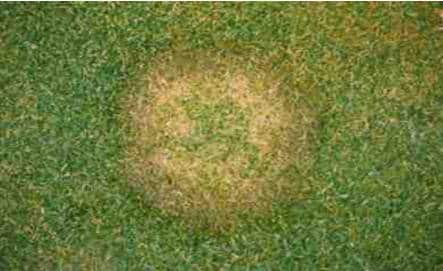Home / Information & advice / Turf & Lawns / Lawn diseases / Fusarium patch disease
Fusarium patch disease is most noticeable as patches of yellow-brown grass which do not hold dew in the mornings.
Under suitable conditions, a usually white mould, sometimes described as cotton-wool or cobwebs, develops on the top of the affected grass area; the mould can also be pink in colour.
The most likely time to see the mould is in the mornings. If no surface mould is apparent then to confirm identification, cover a brown patch overnight and inspect the following day. If mould develops this indicates that the disease is present.

Fusarium patch disease is usually seen in autumn, and then through winter. White moulds or yellow-brown patches at other times of year are unlikely to be Fusarium patch disease.
If weather conditions are at their optimum for Fusarium patch disease it is possible for spores to have a very short incubation period. Therefore, a lawn which was seemingly showing no signs of fungal infection may develop extensive coverage of active Fusarium overnight.
Fusarium patch disease is caused by mild autumnal or winter weather.
Other conditions that assist its development are:
Fusarium fungus (Microdochium (Fusarium) Nivale) is a naturally occurring turf fungus well known by turf professionals. The fungal spores exist within the body of virtually all turf at all times. When climatic conditions are suitable the spores can become very active and result in the development of visible brown patches and mould.
Fusarium patch disease can be made worse by stress to the turf following laying. This may be caused by mowing, walking on and brushing the turf. We suggest that customers try to keep off the turf altogether in the short term. However do mow if necessary.
Fusarium patch disease can develop on all turf. However, it is more visible on grass areas mown to a lower height. Consequently, it is well known to managers of golf clubs where putting greens are often maintained at a height below 7mm. Turf is mown prior to being harvested, this means the sward is relatively short (25mm) and therefore shows the signs of active Fusarium earlier than a lawn maintained at a greater height.
The act of harvesting turf causes stress to the grass plants. Like any disease Fusarium has more impact on the weak and vulnerable, therefore until a new lawn becomes established it is a degree more susceptible to fungal attack.
What steps are taken to prevent Fusarium patch disease on harvested turf?
Fusarium is a disease that has been caused by nature and the best remedy is also provided by nature. A change in weather conditions to colder temperatures, higher light levels and greater air movement usually corrects the problem. It is necessary for these conditions to then prevail to prevent the condition from returning.
The disease will not kill Rolawn turf. The majority of cultivars in Rolawn turf are rhizomatous, consequently reproduction and infill rates are high.
Fungicide treatments are available for Fusarium patch disease. However, Rolawn’s advice is:
Turf will start to recover from the impact of Fusarium patch disease as the onset of spring weather stimulates new growth. The natural increase in growth at this time of year, results in the brown patches gradually being filled in. The time it takes for recovery to occur will depend on prevailing weather conditions and the specific environment in which the turf is growing, the essential requirements being a balance of light, air, water and nutrients. Full recovery will require normal seasonal assistance with suitable mowing, overseeding and feeding activities.
The best defence against Fusarium patch disease is to have a healthy lawn. This means considering the growing environment that the turf is living within throughout the seasons. Provision of light, air, food and water are essential for a healthy lawn. Fusarium, like most fungi, relishes damp, enclosed, still, low light conditions. If it is possible to improve any of these factors this will aid disease resistance in the future.
An appropriate maintenance regime should be followed, including mowing, scarification, feeding, weeding and aeration. A common oversight is the degree of impact surrounding flora and foliage can have on a grassed area. The growth of border plants, shrubs and trees needs to be controlled and monitored to ensure they do not have a detrimental effect on a grassed area. Consequently, pruning and thinning must be considered.
Further advice on Fusarium patch disease can be obtained from STRI UK, the world’s leading sports turf consultancy. Their contact details are STRI, St Ives Estate, Bingley, West Yorkshire, BD16 1AU. Tel: 01274 565131 www.strigroup.com